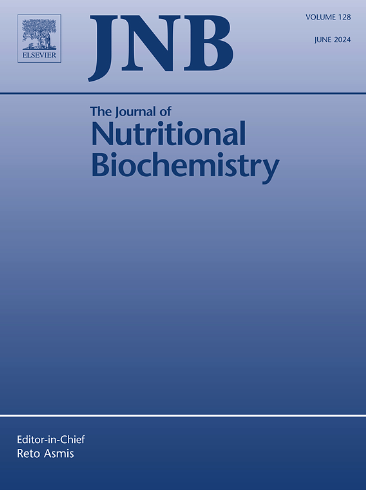Quinoa protein and its hydrolysate improve the fatigue resistance of mice: a potential mechanism to relieve oxidative stress and inflammation and improve energy metabolism
IF 4.8
2区 医学
Q1 BIOCHEMISTRY & MOLECULAR BIOLOGY
引用次数: 0
Abstract
Fatigue is commonly marked by reduced endurance and impaired function, often linked to overexertion and chronic conditions. Quinoa (Chenopodium quinoa Willd.), with its rich amino acids and resilience to harsh conditions, offers a novel strategy for combating fatigue. This study explored the antifatigue effects of quinoa protein (QPro) and its hydrolysate (QPH) in weight-loaded swimming mice. After 4 weeks of oral administration, QPro and QPH significantly prolonged swimming duration, reduced serum fatigue biomarkers (lactic acid, urea nitrogen, lactate dehydrogenase, creatine kinase), and elevated glycogen reserves in the liver and muscle. RT-qPCR analysis indicated that QPH activated hepatic gluconeogenesis via G6Pase and PEPCK signaling and enhanced mitochondrial function through PGC-1α/NRF1/TFAM signaling in muscle. Additionally, QPro and QPH boosted antioxidant defenses by improving antioxidant enzyme activity, reducing malondialdehyde through the Nrf2/HO-1 pathway, and suppressing inflammation by reducing TNF-α and IL-6 levels. Network pharmacology identified 31 key targets involved in energy metabolism and inflammation, providing novel insights into the molecular mechanisms underlying the antifatigue properties of quinoa peptides. These findings highlight the potential of QPro and QPH as natural and bioactive ingredients in functional foods for enhancing endurance and mitigating fatigue.

疲劳通常表现为耐力下降和功能受损,这往往与过度劳累和慢性疾病有关。藜麦(Chenopodium quinoa Willd.)具有丰富的氨基酸和对恶劣条件的适应能力,为消除疲劳提供了一种新策略。本研究探讨了藜麦蛋白(QPro)及其水解物(QPH)对负重游泳小鼠的抗疲劳作用。经过四周的口服给药,QPro 和 QPH 显著延长了游泳时间,降低了血清疲劳生物标志物(乳酸、尿素氮、乳酸脱氢酶、肌酸激酶),并提高了肝脏和肌肉中的糖原储备。RT-qPCR 分析表明,QPH 可通过 G6Pase 和 PEPCK 信号激活肝脏葡萄糖生成,并通过肌肉中的 PGC-1α/NRF1/TFAM 信号增强线粒体功能。此外,QPro 和 QPH 还能提高抗氧化酶活性,通过 Nrf2/HO-1 途径减少丙二醛,并通过降低 TNF-α 和 IL-6 水平抑制炎症,从而增强抗氧化防御能力。网络药理学确定了涉及能量代谢和炎症的 31 个关键靶点,为了解藜麦肽抗疲劳特性的分子机制提供了新的视角。这些发现凸显了 QPro 和 QPH 作为功能食品中的天然生物活性成分在增强耐力和缓解疲劳方面的潜力。
本文章由计算机程序翻译,如有差异,请以英文原文为准。
求助全文
约1分钟内获得全文
求助全文
来源期刊

Journal of Nutritional Biochemistry
医学-生化与分子生物学
CiteScore
9.50
自引率
3.60%
发文量
237
审稿时长
68 days
期刊介绍:
Devoted to advancements in nutritional sciences, The Journal of Nutritional Biochemistry presents experimental nutrition research as it relates to: biochemistry, molecular biology, toxicology, or physiology.
Rigorous reviews by an international editorial board of distinguished scientists ensure publication of the most current and key research being conducted in nutrition at the cellular, animal and human level. In addition to its monthly features of critical reviews and research articles, The Journal of Nutritional Biochemistry also periodically publishes emerging issues, experimental methods, and other types of articles.
 求助内容:
求助内容: 应助结果提醒方式:
应助结果提醒方式:


